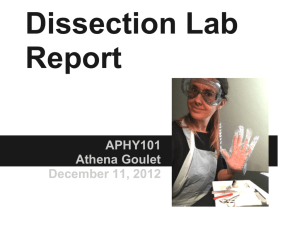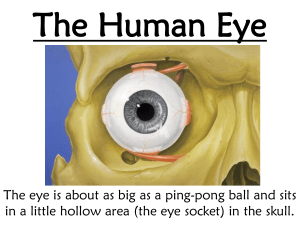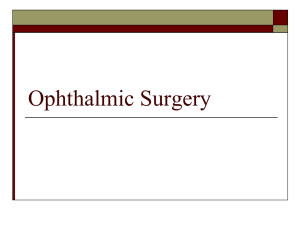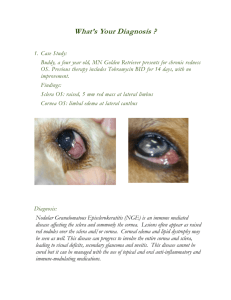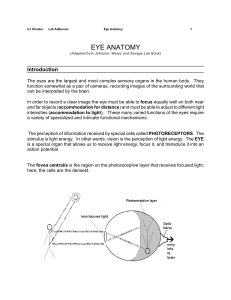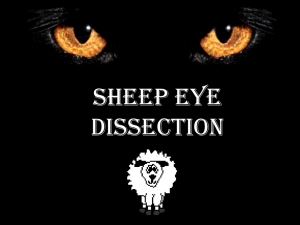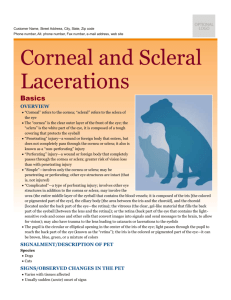Carolina Mammal Eye Dissection Guide
advertisement
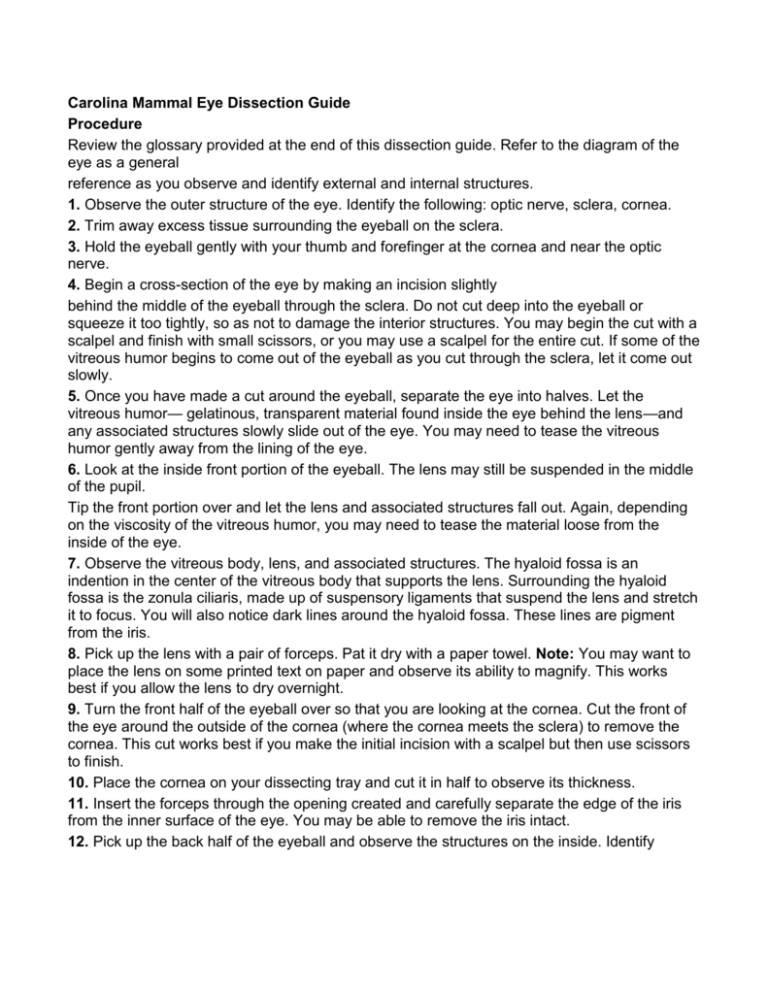
Carolina Mammal Eye Dissection Guide Procedure Review the glossary provided at the end of this dissection guide. Refer to the diagram of the eye as a general reference as you observe and identify external and internal structures. 1. Observe the outer structure of the eye. Identify the following: optic nerve, sclera, cornea. 2. Trim away excess tissue surrounding the eyeball on the sclera. 3. Hold the eyeball gently with your thumb and forefinger at the cornea and near the optic nerve. 4. Begin a cross-section of the eye by making an incision slightly behind the middle of the eyeball through the sclera. Do not cut deep into the eyeball or squeeze it too tightly, so as not to damage the interior structures. You may begin the cut with a scalpel and finish with small scissors, or you may use a scalpel for the entire cut. If some of the vitreous humor begins to come out of the eyeball as you cut through the sclera, let it come out slowly. 5. Once you have made a cut around the eyeball, separate the eye into halves. Let the vitreous humor— gelatinous, transparent material found inside the eye behind the lens—and any associated structures slowly slide out of the eye. You may need to tease the vitreous humor gently away from the lining of the eye. 6. Look at the inside front portion of the eyeball. The lens may still be suspended in the middle of the pupil. Tip the front portion over and let the lens and associated structures fall out. Again, depending on the viscosity of the vitreous humor, you may need to tease the material loose from the inside of the eye. 7. Observe the vitreous body, lens, and associated structures. The hyaloid fossa is an indention in the center of the vitreous body that supports the lens. Surrounding the hyaloid fossa is the zonula ciliaris, made up of suspensory ligaments that suspend the lens and stretch it to focus. You will also notice dark lines around the hyaloid fossa. These lines are pigment from the iris. 8. Pick up the lens with a pair of forceps. Pat it dry with a paper towel. Note: You may want to place the lens on some printed text on paper and observe its ability to magnify. This works best if you allow the lens to dry overnight. 9. Turn the front half of the eyeball over so that you are looking at the cornea. Cut the front of the eye around the outside of the cornea (where the cornea meets the sclera) to remove the cornea. This cut works best if you make the initial incision with a scalpel but then use scissors to finish. 10. Place the cornea on your dissecting tray and cut it in half to observe its thickness. 11. Insert the forceps through the opening created and carefully separate the edge of the iris from the inner surface of the eye. You may be able to remove the iris intact. 12. Pick up the back half of the eyeball and observe the structures on the inside. Identify the retina, which contains the cone and rod receptor cells. Follow this mass of nerve cells to their convergence at the back of the eye, where the optic nerve begins. This is called the blind spot. 13. Turn the back half of the eyeball over and observe the optic nerve on the outside of the eye. Pinch the nerve with your forceps to see the separate fibers of the nerve. 14. Look at the interior of the back portion of the eyeball again. Move the retina so that you can see the dark, metallic-looking tissue at the back of the eye. This is the choroid, a thin layer that lies between the retina and the sclera. The portion of the choroid that appears iridescent blue and green with shades of yellow is called the tapetum. 15. Once you have observed all the structures of the eye, dispose of the specimen in accordance with local guidelines and your teacher’s instructions. Glossary Aqueous humor - clear fluid filling the area between the lens and the cornea, composed mostly of water;helps maintain the shape of the eyeball. Blind spot - area of the retina where the receptor cells converge to form the optic nerve. Choroid - thin, dark sheet of tissue between the retina and the sclera. Cones - receptor cells of the retina that are responsible for perceiving color. Cornea - transparent covering that allows light to enter the eye; on a preserved specimen, the cornea is cloudy. Hyaloid fossa - indention in the center of the vitreous body that supports the lens. Iris - diaphragm that regulates the size of the pupil. Lens - biconvex transparent structure that focuses the light coming in through the cornea and pupil. Optic nerve - bundle of nerve cells that send signals from the eye to the brain. Pupil - opening through which light enters the eye. Retina - light-sensitive portion of the eye composed of receptor cells called cones and rods. Rods - receptor cells of the retina that are responsible for perceiving difference in light intensity. Sclera - outer covering of the eyeball; a tough, opaque sheet of connective tissue that protects inner structures of the eyeball and helps maintain rigidity. Tapetum - iridescent portion of the choroid tissue. Vitreous body - the cavity between the retina and the back of the lens. Vitreous humor - viscous fluid that fills the vitreous body; helps maintain the shape of the eyeball. Zonula ciliaris - ligaments that suspend the lens and stretch it to focus vision.



